Having the ability to create light without needing electricity should be part of everyone’s emergency essentials. While flashlights are certainly helpful, batteries quickly die out so having a store of candles on hand can provide the light and morale boost that one needs to make it through a dark night or two. But what if you didn’t have any candles available?
This informative article can be found at Tactical Intelligence
Fortunately there are very simple ways to make homemade lamps from everyday objects found around the house. In this article I’ll be teaching you the principles of how a simple lamp works and showing you a few examples so that if needed you can make your own.
How a Lamp Works
Both oil lamps and candles are able to continually burn their fuel (wax or oil) through a process called capillary action. You can easily see this process by dipping the corner of a paper towel in liquid. The liquid gets drawn up into the paper towel which is called capillary action.
Understanding this is the key to creating many different types of wicks for your homemade lamps. As long as the material is absorbent, it will be able to draw the fuel up into itself to be burned by the flame.
Making a Tuna Fish Can Oil Lamp
Here’s a simple example of how to make your own oil lamp using a tuna fish can. What you’ll need is the following: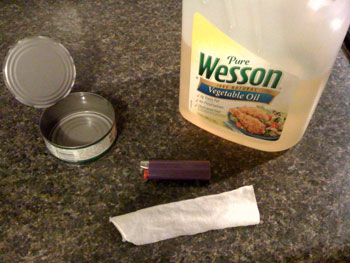

- Tuna Can
- Vegetable Oil, Olive Oil or any other cooking oil
- Old Cotton T-Shirt, Rag, or Sock
- Nail (or something sharp to poke a hole through the top of the tuna can)
What you’ll need to do is:
- Poke a nail-sized hole through the center of the can with a nail or other sharp object.
- Using a can opener, partially open the tuna can so that you can empty the ingredients.
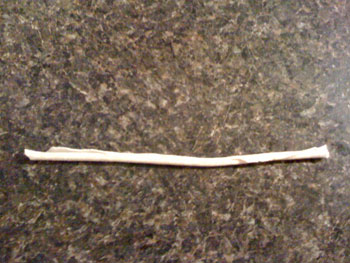 Cut a 2 inch by 8 inch strip of material from an old cotton t-shirt, rag, or sock.
Cut a 2 inch by 8 inch strip of material from an old cotton t-shirt, rag, or sock.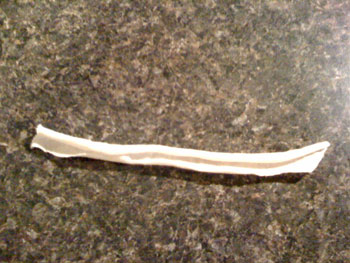 Roll the cotton strip into a long wick (you can optionally twist it as well).
Roll the cotton strip into a long wick (you can optionally twist it as well).- Feed a half-inch length of the wick through the poked hole in the top of the tuna can with the remainder of the wick coiled in the bottom of the can.
- Fill the can up 3/4 of the way with oil and let the wick soak up the oil. You can also pre-soak the top of the wick.
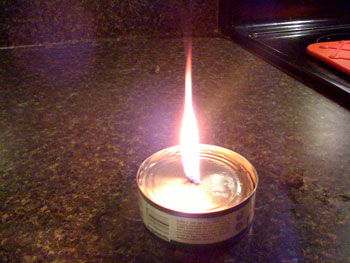 Light the wick.
Light the wick.
As the oil soaked up in the wick burns off, it will continually draw up new oil from the bottom of the can and provide hours of light.
The great benefit of using cooking oil is that similar to a candle if the lit lamp were to fall it will not ignite (kerosine lamps are dangerous in this way). It’s a very safe form of light.
Also if you’re worried about the smell, it’s actually quite minimal (with Olive Oil being practically scentless).
Making a Bacon Grease Candle
Here’s another example of a homemade lamp/candle. In this example I’ll be demonstrating how to make a homemade candle using saved bacon grease.
Bacon grease when solidified is nothing other than rendered tallow (lard). When fat from an animal is heated it melts into a liquid and when filtered through a mesh and cooled until it solidifies you get tallow.
Tallow, similar to wax, provides a great source of fuel for a homemade candle. Again, any type of cooking grease (such as Crisco) can be used. To make one, what you’ll need is the following: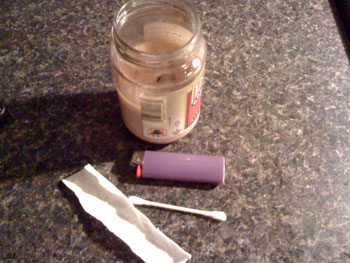

- A glass container containing tallow (in this case bacon lard)
- A cotton swab (Q-tips)
- Old Cotton T-Shirt, Rag, or Sock
What you’ll need to do is:
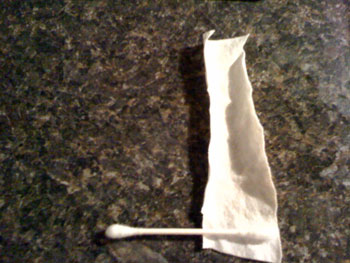 Cut a 2 inch by 6 inch strip of material from an old cotton t-shirt, rag, or sock.
Cut a 2 inch by 6 inch strip of material from an old cotton t-shirt, rag, or sock.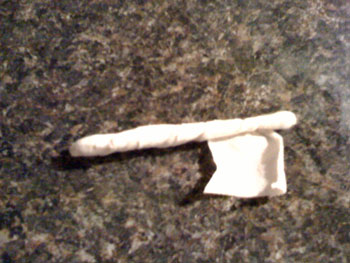 Wrap the cotton strip around the Q-tip, covering it completely.
Wrap the cotton strip around the Q-tip, covering it completely.- Stick the wrapped Q-tip in the bacon lard until only a half an inch is exposed.
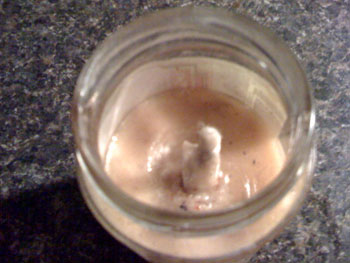 Smear a little bacon lard on the exposed cotton wrapping.
Smear a little bacon lard on the exposed cotton wrapping.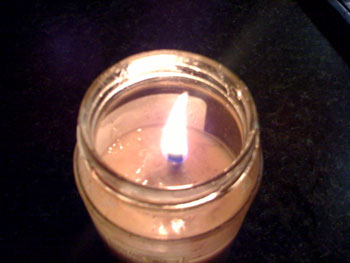 Light the wick.
Light the wick.
As you can imagine, burning bacon grease can give off a slight bacon smell.
Now a word from Lori,
I do know how to make other lighting sources that I will post later. As a teaser they are inexpensive, hard working, and easy to do.
Did you know you can go to the meat department at Macey's and ask for fat? They will give you FREE FAT, that you can go home and render yourself. It is really easy to render fat. I did it in my oven. Super simple. FREE fat to render down for candles, soap, or lard. Did you hear me ... FREE! If that isn't an example of Provident Living what is?
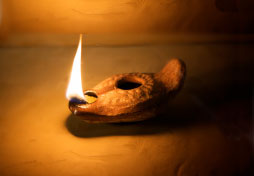
No comments:
Post a Comment
You are welcome to ask questions or leave a comment.
Note: Only a member of this blog may post a comment.